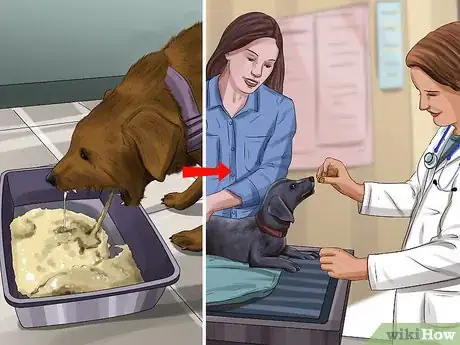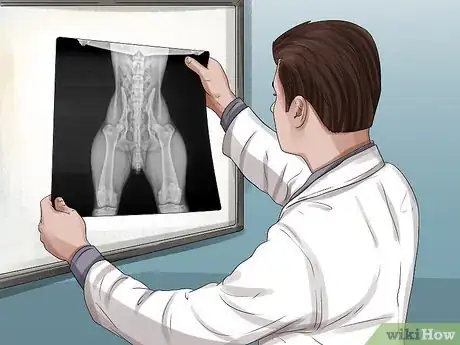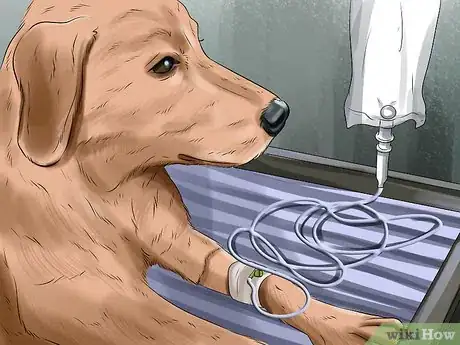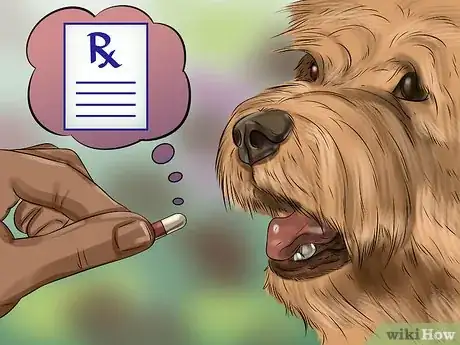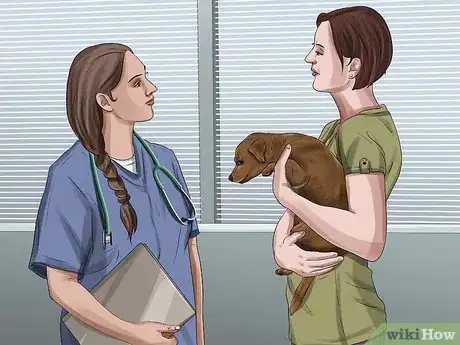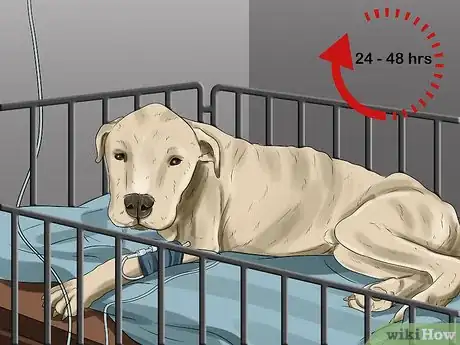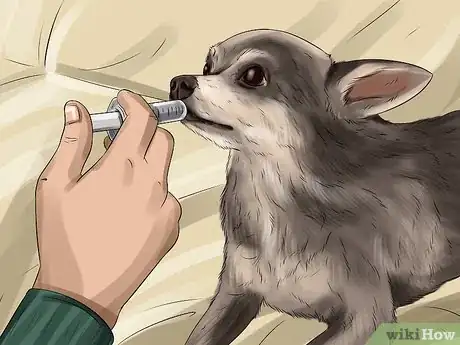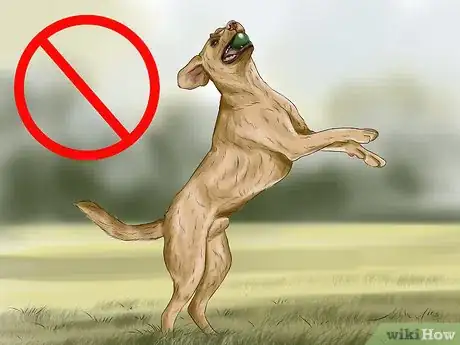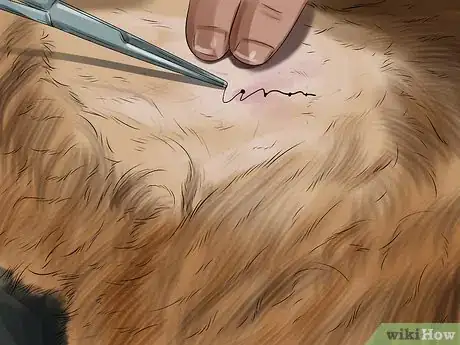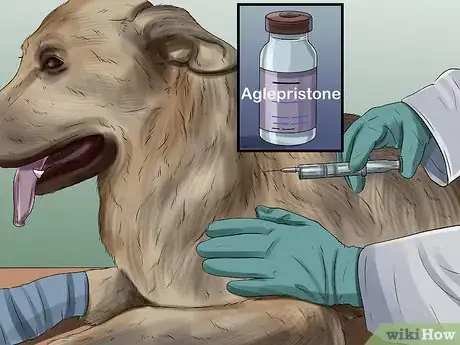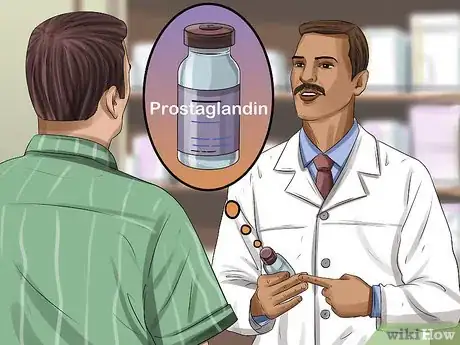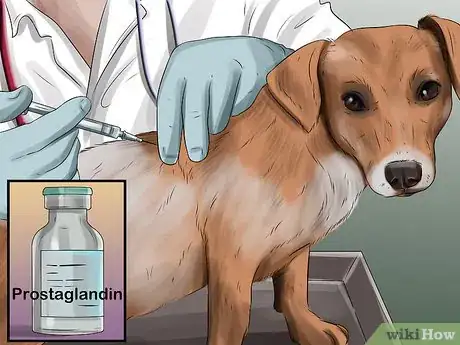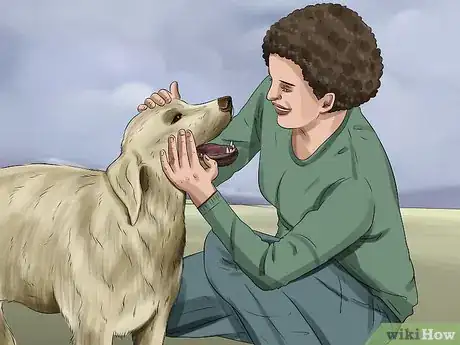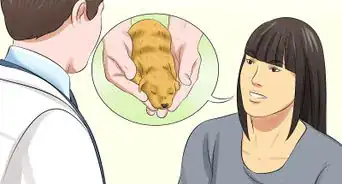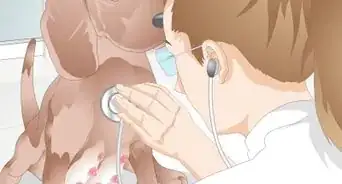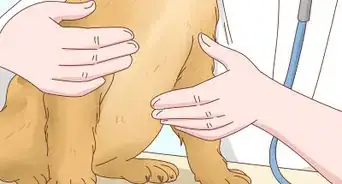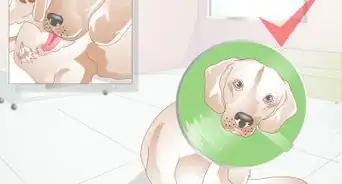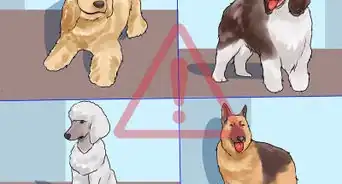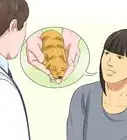This article was co-authored by Pippa Elliott, MRCVS. Dr. Elliott, BVMS, MRCVS is a veterinarian with over 30 years of experience in veterinary surgery and companion animal practice. She graduated from the University of Glasgow in 1987 with a degree in veterinary medicine and surgery. She has worked at the same animal clinic in her hometown for over 20 years.
There are 10 references cited in this article, which can be found at the bottom of the page.
wikiHow marks an article as reader-approved once it receives enough positive feedback. In this case, 94% of readers who voted found the article helpful, earning it our reader-approved status.
This article has been viewed 48,994 times.
Pyometra is an infection of the uterus that can cause serious problems in female dogs. Symptoms appear a few weeks after the dog's heat cycle ends. The sooner you can treat your dog’s pyometra, the better its outcome will be. Take your dog to the vet so that it can receive an IV and antibiotics. In most cases, your dog will require surgery. If you want to still breed your dog, you may be able to avoid surgery, although you should understand that this option carries its own risks.
Steps
Starting Treatment with Your Vet
-
1Take the dog to the vet as soon as you notice symptoms. Symptoms normally appear after the dog has finished heat. Even if you only notice 1 symptom of pyometra after heat, take your dog to the vet as soon as possible. Common symptoms include:[1]
- White, yellow, green, or clear discharge from the vagina
- Excessive licking of the vagina
- Increased thirst
- Decreased appetite
- Swollen or painful abdomen
- Change in behavior
- Lethargy
- Vomiting
- Fever
-
2Determine whether it is open or closed cervix pyometra. The vet may do a number of tests, such as a physical examination, X-rays, ultrasound scans, and blood tests. If the dog has pyometra, the vet will tell you if it is open or closed pyometra.[2]
- Open cervix pyometra occurs means that the cervix of the dog is open. Pus will drain from the uterus out through the dog’s vagina. While still potentially life threatening, open pyometra is less complicated to treat.
- In closed cervix pyometra, the cervix becomes sealed off, and pus builds up in the dog’s uterus. It is essential to perform surgery soon to prevent the uterus from rupturing.
- Closed pyometra is more of an immediate medical emergency than open pyometra. That said, your vet will likely want to act quickly regardless.
Advertisement -
3Rehydrate your dog at the vet. Dogs with pyometra are often dehydrated because the condition impairs kidney function. Your vet may hook your dog up to an IV to provide fluids. Your dog may need fluids for anywhere between 2-24 hours.[3]
- Fluids may be given when your dog first visits the vet or right before surgery. In more severe cases, dogs may need IV treatment for longer.
-
4Give your dog its prescribed medication. Your vet will prescribe the dog antibiotics to try to control the infection before surgery. If your dog is in pain, the vet may also prescribe a pain medication.[4]
- Usually, the medication will come in pill form. Try hiding the medication in food or a treat to encourage your dog to swallow it.
- If your dog was hospitalized, your vet will administer the medication.
- Make sure to give your dog the full course of antibiotics. Do not stop giving your dog its pills because it begins to look better.
Doing Surgery and Providing Aftercare
-
1Talk to your vet about the surgical procedure. The type of surgery that your vet will do is called an ovariohysterectomy. It will remove your dog’s uterus and ovaries, effectively spaying your dog. Feel free to ask your vet any questions you have about the procedure.[5]
- Before surgery, the vet will likely shave a patch of your dog’s fur. Don’t worry. It will grow back.
- During surgery, your vet will give your dog anesthesia. They will open up the dog’s abdomen to reach the womb.
- At the end of the surgery, your dog will receive stitches to close the wound.
-
2Leave your dog in the care of the hospital for 24-48 hours. Your dog will most likely be hospitalized for a day or 2 after surgery. The vet will watch for any bleeding or signs of infection. They will also continue to give the dog fluids through an IV.
- Your vet will likely call you once the surgery is over so that you can check in on your dog.
-
3Give your dog its medication when you bring it home. When your dog is eating and drinking without vomiting and able to defecate on its own, it will be allowed to go home with a course of new antibiotics and pain relief medications. Give your dog these medications for 10-14 days after surgery.[6]
- As with the previous course of antibiotics, make sure to give your dog its pills every day until the course is done.
-
4Avoid heavy activity with your dog for up to 2 weeks. Keep an eye on your dog to make sure that it is not playing vigorously or doing anything that could disturb its stitches. Avoid letting your dog off the leash outside. If possible, don’t let your dog climb stairs.[7]
- A cone or pillow collar may be needed to keep your dog from chewing its stitches. Your vet can give you 1 or you can buy it at a pet store.
- Keep your dog distracted with chew toys and puzzle toys. Avoid tug of war or fetch while the dog heals.
- Make sure to show your dog lots of love during this time!
-
5Bring your dog back to have its stitches removed. The sutures will be removed approximately 10 to 14 days after the operation, at which point your dog should be as good as new.
- Be sure to watch out for any bleeding around the wound while the stitches are still in place. If you notice any bleeding, take your dog back to the vet.[8]
- If your dog is unable to eat or urinate after surgery, take it back to the vet to get checked out.
Trying Medications as a Riskier Alternative
-
1Ask your vet if medications are an option. If your dog has open pyometra and you want to continue breeding her, medications may be an option. Understand, however, that these carry their own risk. The chances of recovery are more uncertain.
- Not all veterinarians are prepared to offer this form of treatment. The dog may not necessarily recover using just medications. Pyometra is likely to return without surgery.
- In some cases, your vet may want to hospitalize the dog so they can monitor it during in treatment. In other cases, you may be allowed to treat your dog at home.
- If your dog is severely ill, it may need surgery to survive, especially if it has a closed cervix. A closed cervix could rupture the uterus, causing sepsis and death.
-
2Give your dog aglepristone if you live in Europe. Available in the UK and some other European countries (but not currently in the US), aglepristone helps the uterus expel pus. Your vet will give your dog 3-4 injections on different days.[9]
- Aglepristone causes the cervix to relax, so there is less risk of uterine rupture than with other medications.
- This medication should not be used on dogs with liver or kidney problems.
-
3Get prostaglandin injections for dogs with open cervix pyometra. Prostaglandins are hormones that can help your dog’s uterus expel bacteria and pus. It should only be used in dogs with open pyometra, as it could cause the uterus to rupture in dogs with closed pyometra.[10]
- Side effects include restlessness, anxious behavior, panting, excessive drooling, and vomiting. Return to the vet if you notice these signs.
- This is a good treatment option if you want to continue breeding your dog after treatment. Be aware, however, that it won’t cure late stage pyometra.
- Prostaglandins aren’t officially approved for use in cats and dogs, which means that your vet might prescribe it “off-label.” This is legal, but it means that the effects of the drug on your dog are still uncertain.
-
4Combine a dopamine agonist with prostaglandins. If your dog is using prostaglandins, your vet may prescribe a second medication called a dopamine agonist. This can improve the effectiveness of prostaglandins. Your vet will inject these with the prostaglandins.[11]
-
5Monitor your dog after each heat to see if pyometra returns. Unlike surgery, which can prevent recurrence of pyometra completely, dogs treated with medications have a 50-75% of getting pyometra again. After your dog goes through heat, watch it carefully for any new signs of pyometra.[12]
- Some vets may recommend that your dog become pregnant during its next heat to prevent the return of pyometra.
Warnings
- Without treatment, your dog’s uterus could rupture, which is nearly always fatal. Quick treatment is necessary.⧼thumbs_response⧽
- While pyometra is most common in dogs over the age of 8, it can occur in younger dogs.⧼thumbs_response⧽
References
- ↑ http://www.dogsnaturallymagazine.com/treatment-options-pyometra-dogs/
- ↑ https://www.merckvetmanual.com/reproductive-system/reproductive-diseases-of-the-female-small-animal/pyometra-in-small-animals
- ↑ https://www.dvm360.com/view/surgical-and-medical-treatment-pyometra
- ↑ https://www.merckvetmanual.com/reproductive-system/reproductive-diseases-of-the-female-small-animal/pyometra-in-small-animals
- ↑ ovariohysterectomy
- ↑ https://vcahospitals.com/know-your-pet/pyometra-in-dogs
- ↑ https://www.acvs.org/small-animal/pyometra
- ↑ https://www.ncbi.nlm.nih.gov/pubmed/25323211
- ↑ https://www.merckvetmanual.com/reproductive-system/reproductive-diseases-of-the-female-small-animal/pyometra-in-small-animals
About This Article
To treat pyometra in dogs, it's important that you take your dog to the vet as soon as you notice symptoms so they can rehydrate it and prescribe antibiotics. They'll also likely need to perform surgery and spay your dog. However, if you want to continue breeding your dog, talk to your vet about possible alternatives to surgery, like medication. Just keep in mind that some vets don't offer medication as an alternative, and it's less effective than surgery. For more advice from our Veterinary co-author, like how to recognize the symptoms of pyometra, read on.
